|
Three Rings for the Elven-kings under the sky,
Seven for the Dwarf-lords in their halls of stone,
Nine for the Mortal Men doomed to die,
One for the Dark Lord on his dark throne
In the Land of Mordor where the shadows lie,
One Ring to rule them all, One Ring to find them,
One Ring to bring them all and in the darkness bind them,
In the Land of Mordor where the Shadows lie.
– The Lord of the Rings, by JRR Tolkien
This is the final part of the present series discussing the life
of author and scholar JRR Tolkien and his inspirations in the Midlands of England,
and perhaps the most controversial.
The first parts comprised a concise biography and early bibliography,
and a tour of places in the Birmingham area where Tolkien lived in his childhood,
and which are said to have influenced and inspired the author when he came to
write his much-loved books ‘The Hobbit’ and ‘The Lord of the
Rings’. These influences are fairly well-established, although occasionally
open to some debate.
One area which is also often claimed to have had a darker influence,
however, is open to far more conjecture, as Ronald Tolkien never, as far as I
am aware, went into any detail about his inspirations for places in the Land of
Mordor, home of the dark Lord Sauron, chief instigator and inspiration for most
of the evil to be found in Tolkien’s fantasy works.
Tolkien makes clear his distaste for industry and its unnatural
destruction of the countryside. Whether he deliberately wrote The Lord of the
Rings to make this point is debatable, but it is undeniable that this abhorrence
influenced his thinking and his writing, however unconsciously.
As a result of this, and of its proximity to Birmingham, it is
often suggested that one area in particular may have inspired Mordor – a
place, in fact a series of towns, heavily industrialised, run-down and blackened
by centuries of industrial revolution and poverty, and only in the late 20th century
managing to drag itself into the light of day. This place is known as ‘The
Black Country’.
This article aims to let a little light into the shadowy corners
of Mordor by suggesting some places that if Tolkien had seen them, might indeed
have sparked thoughts of the black land of legend, and to give you, gentle reader,
the chance to see them in a brief tour herein.
Tolkien purists already foaming at the mouth with indignation
should remember, however, that this article claims no greater authority than mere
conjecture in the spirit of fun. This author, being a denizen of The Black Country,
simply allows himself a little amusement and speculation in the light that he
may yet live today in the land of Orcs and Goblins, of rock trolls, black riders,
of Mount Doom and barad-dur, and the all-seeing Eye of Sauron, Oh my!
Where is The Black Country?
‘Day was coming again in the world outside, and far
beyond the glooms of Mordor the sun was climbing over the eastern rim of Middle-Earth,
but here all was still dark as night. The Mountain smouldered and its fires went
out. The glare faded from the cliffs. The eastern wind that had been blowing ever
since they left Ithilien now seemed dead.’
– The Return of the King
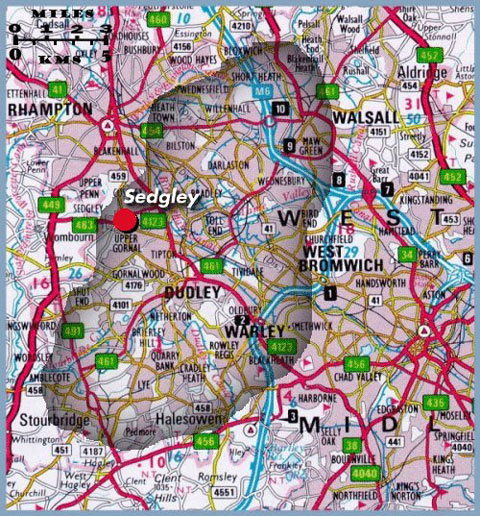
The Black Country – shaded area.
Note Bloxwich, my home, on the northeastern border!
The Black Country, in fact, borders on the Birmingham area, in
the Midlands of England, and as you can see from the map, it is not far from Tolkien’s
homes in Sarehole (Hobbiton, The Old Forest) near Moseley, and Edgbaston (The
Two Towers, Orthanc), so it would make sense that Tolkien might be influenced
by it.
This group of towns, some small, some large, was at the heart
of the industrial revolution of the 18th and 19th centuries, and became known,
because of its black ground and the choking black smoke from innumerable furnaces,
as the Black Country.
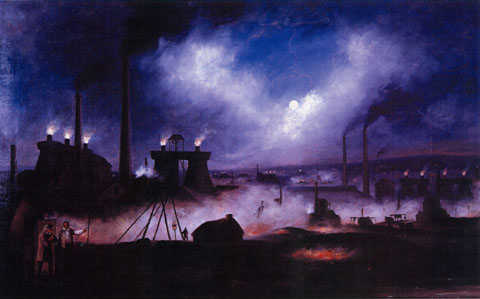
Wednesbury by Night, mid 19th century
painting
Elihu Burritt, the American Consul to Birmingham in 1862, said
that the place was ‘Black by day and red by night’. In Tolkien’s
youth, certainly, it was. Today, The Black Country owes much of its heritage and
image to the period when the iron and steel industry was at its height, but has
also cleaned up its act a great deal, and has made great efforts to modernise
and become more clean and green.
The boundaries of the Black Country are somewhat hazy and often
the subject of much pedantic debate, but in today’s tourist-conscious times,
four main Boroughs, each incorporating many Black Country towns and villages,
all lay claim to be part of it: Dudley, Walsall, Wolverhampton and Sandwell.
Certainly, Dudley is at the heart of it, as are many parts of
the other Boroughs. These days, part of nearby Warley comes under Sandwell, and
some of it tends to get lumped in with Birmingham, but it has a historical claim
to being part of The Black Country, and any trek to the heart of Mordor from The
Two Towers would surely have led through it.
Whatever its boundaries, the Black Country was certainly something
that would dismay Tolkien and nature lovers anywhere. Great iron foundries and
abominable structures abounded, just as the open-cast quarries and deep mines
scarred the land. Grim and black indeed: certainly the Mordor amongst us.
While The Black Country today is by no means as black as it’s
painted, and is a great place to live, being full of friendly people (orcs being
rarely seen nowadays!) , fascinating heritage, pubs, Staffordshire Bull Terriers,
ghosts (grin) and even the odd green patch of vegetation, you can still see that
when young Ronald Tolkien was a lad, it would have been a grim place indeed, bustling,
harsh, noisy, black and dirty.
But where to site the chief dark places of Mordor?
The Morannon, or Black Gate
– Blackheath
‘This was Cirith Ungor, the Haunted Pass, the entrance
to the land of the Enemy… …Across the mouth of the pass, from cliff
to cliff, the dark Lord had built a rampart of stone. In it there was a single
gate of iron, and upon its battlement sentinels paced unceasingly. Beneath the
hills on either side the rock was bored into a hundred caves and maggot-holes;
there a host of orcs lurked, ready at a signal to issue forth like black ants
going to war. None could pass the Teeth of Mordor and not feel their bite, unless
they were summoned by Sauron, or knew the secret passwords that would open the
Morannon, the black gate of his land’.
– The Two Towers
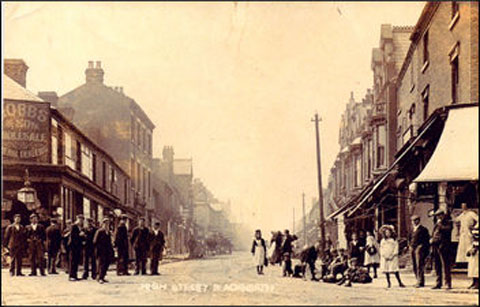
High Street, Blackheath, photographed
from the junction with Halesowen Street in 1905.
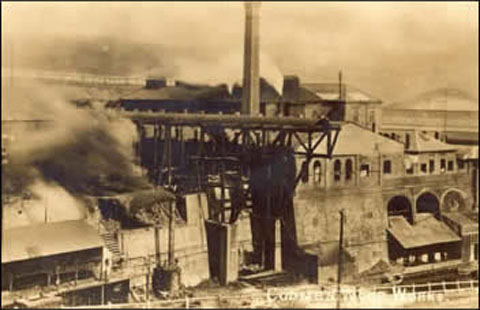
Coombs Wood Works in Rowley Regis was
an independent steel producer before being taken over by British Steel, and was
responsible for the influx of many workers from South Wales into the area.
Directly on the route from The Two Towers – Minas Tirith
and Minas Morgul – lies the chief entrance to Mordor – The Morannon
or ‘Black Gate’. In the ‘real world’, geographically speaking,
a fine place to situate the Black Gate would be at the all-too-similarly named
‘Blackheath’ or ‘Black Heath’, a rather run-down but nonetheless
historic town within the area of Rowley Regis, now in the Borough of Sandwell.
The development of Rowley into an industrial area had very early
beginnings going back to Roman times, but the first recorded industry of the Manor
of Rowley was nail making which started in the 13th Century. The development of
coal and iron industries led to a rapid transformation of the region from green
to Black Country. By 1880 over fifty collieries poured their smoke into the atmosphere,
and four blast furnaces lit up the night sky. Truly a candidate for part of Mordor.
Mount Doom
– Sedgley Beacon
‘Still far away, forty miles at least, they saw mount
Doom, its feet founded in ashen ruin, its huge cone rising to a great height,
where its reeking head was swathed in cloud. Its fires were now dimmed, and it
stood in smouldering slumber, as threatening and dangerous as a sleeping beast.
Behind it there hung a vast shadow, ominous as a thunder-cloud, the veils of Barad-dur
that was reared away on a long spur of the Ashen Mountains thrust down from the
North.’
– The Return of the King
Mount Doom, or the volcano Orodruin, stood in the plateau of
Gorgoroth in northwestern Mordor. With an elevation of some 4,500 feet, and a
base of seven miles diameter, it would not be much competition for Mount Etna
in Italy, which towers some 11,000 feet and has a base of around 21 miles diameter,
but nonetheless it was a sinister and dangerous place.
Frodo entered the Chambers of Fire and approached the Crack of
Doom through tunnels, certainly tunnels are common in The Black Country –
the former limestone mines, now abandoned caves, at Wren’s Nest in Dudley,
and in Castle Hill, are a few of the man-made examples of such in the area.
I have placed Barad-dur on Castle Hill (see more below), and
thusly, geographically placed to the east of Barad-dur, Mount Doom may most attractively
be identified with Sedgley Beacon, a prominent hill famed in its name for the
great fires once lit atop its heights. While not on the same scale as the ‘real’
Mount Doom, it is certainly in the ‘right’ place.
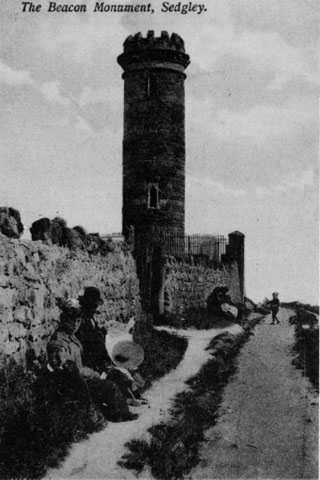
Sedgley Beacon, 1904
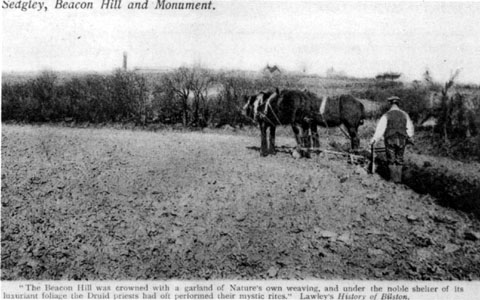
Sedgeley, Beacon Hill and Monument in
the distance, c.1921
Sedgley Beacon is situated on a limestone ridge, 654 feet above
sea level. It gets its name from a great signal fire once lit atop the hill, perhaps
as part of the series set up in Tudor times or earlier to warn against invasion
from the sea.
Victorian historians once entertained the thought that ancient
Druid priests had ‘oft performed their mystic rites’ atop the Beacon,
and though modern scholars might pour scorn on this, such rites might well inspire
thoughts of Sauron’s magical ring-forging in the flames of Oroduin.
The Beacon Monument, which can still be visited today, is a circular
stone tower built in 1846 by Lord Wrottesley for astronomical observations and
as a fitting landmark for Sedgley Beacon.
It certainly also seems fitting that this high place near the
centre of The Black Country, with, historically, a great flame at its summit,
might symbolise the mighty volcano of Orodruin or Mount Doom, where the Rings
of Power were forged, and where the One Ring was destroyed. It even happens to
be west of Dudley Castle, where I have placed Barad dur, as it was in The Lord
of the Rings.
Oddly enough, in geological time, there were volcanoes in the
area, in the vicinity of nearby Wolverhampton, and volcanic rock was long quarried
at Rowley Regis, but none at Sedgley itself.
‘Barad-dur’ – the Dark Tower of Sauron
– Dudley Castle
‘…for here as the mountain drew near the air
was ever mirky, while out from the Dark Tower there crept the veils of Shadow
that Sauron wove about himself.’
- The Return of the King
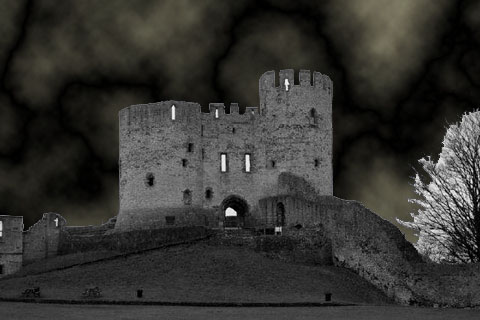
The Keep of Dudley Castle
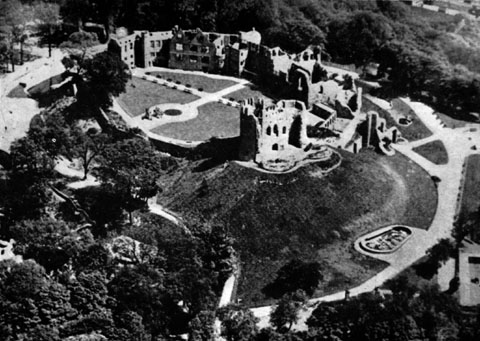
Dudley Castle towers over the Black
Country
For over 900 years Dudley Castle has surveyed from its lofty
vantage-point the changing face of the surrounding landscape. This most important
of the town's buildings was mentioned in the Domesday Book when the small village
of Dudley nestled amidst fields and woods. During the days of the Industrial Revolution,
the fields were built on and the woods cut down for building materials and to
burn.
Coal, iron and limestone were mined, to make iron and steel for
industry, and to build steam engines, railways and iron ships, to such an extent
that many parts of The Black Country suffer from subsidence even today.
Dudley Castle is at the heart of The Black Country, and occupies
a truly commanding position on Castle Hill, near the centre of the modern town.
Castle Hill itself is a fascinating place, full of caves and
canal tunnels to the nearby Wren’s Nets limestone caverns. It overlooks
a remnant of historic Black Country industry much beloved of tourists, the Black
Country Living Museum, where the visitor may get some feel of what it would have
been like to live and work in the area during Tolkien’s youth.
Could Tolkien have visited Dudley, and been inspired by the ancient
castle on the tunnelled hill to dream of Sauron’s dark tower of Barad-dur?
Who can say, but I know that it inspires me. Hopefully, it will inspire you, young
Hobbit.
So ends, gentle reader, my series of articles introducing to
you to the life of JRR Tolkien and some of the locations in the Birmingham area
which have influenced the landscape of The Hobbit and, most significantly, The
Lord of the Rings. I hope that you have enjoyed the quest, and may be inspired
to visit these places yourself one day. If you do, please contact me – I
would love to show you around his world.
It may be that in the future I will return to the world of JRR
Tolkien to introduce you to his haunts in Oxford, during the days when he became
a great scholar and the author whom we know and love today. But that, young Hobbit,
is another story…
Stuart Williams
Bloxwich, England
|